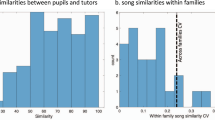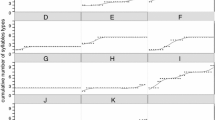Abstract
Songbirds learn to sing by modeling their songs on the songs of other males through a process of social learning. Models of social learning predict that animals should be selective in what and when they learn. In this study, we asked whether young males in a wild population of the Puget Sound white-crowned sparrow, Zonotrichia leucophrys pugetensis, were selective in their choice of tutor models and what factors influenced how accurately they imitated tutors’ songs. We first examined two strategies for tutor choice: whether pupils have a conformity bias and/or a preference for high-quality tutors. In keeping with a conformity bias, tutors that sang song types that were relatively common within a radius of about 500 m of their territory were more likely to be imitated than were tutors that sang rarer song types. Most potential tutors were not imitated by pupils. Aspects of tutor quality, such as age, pairing status, and survival to the next year had no effect on whether a tutor’s song was imitated. Secondly, we tested whether pupil repertoire size, pupil quality, and local abundance of tutor models affected the accuracy of song imitations. We found a trade-off between repertoire size and tutor imitation accuracy with males that sang two or more song types developing significantly poorer imitations than males that sang one type. We discuss possible functions of a conformity learning strategy and factors that could produce a trade-off between imitation accuracy and repertoire size.






Similar content being viewed by others
References
Baker MC, Gammon DE (2008) Vocal memes in natural populations of chickadees: why do some memes persist and others go extinct? Anim Behav 75:279–289
Baptista LF (1975) Song dialects and demes in sedentary populations of the white-crowned sparrow (Zonotrichia leucophrys nuttalli). Univ Calif Publ Zool 105:1–52
Baptista LF (1977) Geographic variation in song and dialects of the Puget Sound white-crowned sparrow. Condor 79:356–370
Baptista LF, Morton ML (1988) Song learning in montane white-crowned sparrows: from whom and when. Anim Behav 36:1753–1764
Beecher M (2008) Function and mechanisms of song learning in song sparrows. Adv Stud Behav 38:167–225
Beecher MD, Campbell SE, Stoddard PK (1994) Correlation of song learning and territory establishment strategies in the song sparrow. Proc Natl Acad Sci U S A 91:1450–1454
Bell DA, Trail PW, Baptista LF (1998) Song learning and vocal tradition in Nuttall’s white-crowned sparrows. Anim Behav 55:939–956
Boyd R, Richerson PJ (1985) Culture and the evolutionary process. Univ. of Chicago, Chicago
Burnham KP, Anderson DR (1998) Model selection and inference: a practical information-theoretic approach. Springer, New York
Catchpole CK, Slater P (2008) Bird song, 2nd edn. Cambridge University Press, Cambridge
Chilton G, Lein MR (1996) Song repertoires of Puget Sound white-crowned sparrows Zonotrichia leucophrys pugetensis. J Avian Biol 27:31–40
DeWolfe BB, Baptista LF (1995) Singing behavior, song types on their wintering grounds and the question of leap-frog migration in Puget Sound white-crowned sparrows. Condor 97:376–389
Engineering Design (2009) Signal reference guide, 5.04 edn. Engineering Design, Berkeley
Ghisletta P, Spini D (2004) An introduction to generalized estimating equations and an application to assess selectivity effects in a longitudinal study on very old individuals. J Educ Behav Stat 29:421–437
Grant BR, Grant PR (1996) Cultural inheritance of song and its role in the evolution of Darwin’s finches. Evolution 50:2471–2487
Greig EI, Taft BN, Pruett-Jones S (2012) Sons learn songs from their social fathers in a cooperatively breeding bird. Proc R Soc Lond B 279:3154–3160
Harbison H, Nelson DA, Hahn TP (1999) Long-term persistence of song dialects in the mountain white-crowned sparrow. Condor 101:133–148
Hardin J, Hilbe J (2003) Generalized estimating equations. Chapman & Hall, Boca Raton
Hoppitt W, Laland KN (2013) Social learning. Princeton University Press, Princeton
Hughes M, Hultsch H, Todt D (2002) Imitation and invention in song learning in nightingales (Luscinia megarhynchos B., Turdidae). Ethology 108:97–113
Hultsch H, Todt D (1992) The serial order effect in the song acquisition of birds: relevance of exposure frequency to song models. Anim Behav 44:590–592
Jenkins PF (1977) Cultural transmission of song patterns and dialect development in a free-living bird population. Anim Behav 25:50–78
Johnson F, Soderstrom K, Whitney O (2002) Quantifying song bout production during zebra finch sensory-motor learning suggests a sensitive period for vocal practice. Behav Brain Res 131:57–65
Kokko H (1999) Competition for early arrival in migratory birds. J Anim Ecol 68:940–950
Krebs JR, Kroodsma DE (1980) Repertoires and geographical variation in bird song. Adv Stud Behav 11:143–177
Kroodsma DE (1974) Song learning, dialects, and dispersal in the Bewick’s wren. Z Tierpsychol 35:352–380
Lahti DC, Moseley DL, Podos J (2011) A tradeoff between performance and accuracy in bird song learning. Ethology 117:802–811
Laland KN (2004) Social learning strategies. Learn Behav 32:4–14
Marler P (1970) A comparative approach to vocal learning: song development in white-crowned sparrows. J Comp Physiol Psychol Monogr 71:1–25
Marler P, Peters S (1977) Selective vocal learning in a sparrow. Science 198:519–521
Marler P, Peters S (1981) Sparrows learn adult song and more from memory. Science 213:780–782
Marler P, Peters S (1982a) Long-term storage of learned birdsongs prior to production. Anim Behav 30:479–482
Marler P, Peters S (1982b) Subsong and plastic song: their role in the vocal learning process. In: Kroodsma DE, Miller EH (eds) Acoustic communication in birds: II. Song learning and its consequences. Academic Press, New York, pp 25–50
Marler P, Tamura M (1962) Song “dialects” in three populations of white-crowned sparrows. Condor 64:368–377
Morton ML (2002) The mountain white-crowned sparrow: migration and reproduction at high altitude. Stud Avian Biol-Ser 24:1–236
Morton ML, Wakamatsu MW, Pereyra ME, Morton GA (1991) Postfledging dispersal, habitat imprinting, and philopatry in a montane, migratory sparrow. Ornis Scand 22:98–106
Mundinger PC (1982) Microgeographic and macrogeographic variation in acquired vocalizations of birds. In: Kroodsma DE, Miller EH (eds) Acoustic communication in birds. Academic Press, New York, pp 147–208
Nelson D, Poesel A (2013) Song sharing correlates with pairing success, but not territory tenure in the Puget Sound white-crowned sparrow. Behav Ecol Sociobiol 67:993–1000
Nelson DA (2000) Song overproduction, selective attrition, and vocal dialects in the white-crowned sparrow. Anim Behav 60:887–898
Nelson DA, Hallberg KI, Soha JA (2004) Cultural evolution of Puget Sound white-crowned sparrow song dialects. Ethology 110:879–908
Nelson DA, Marler P (1994) Selection-based learning in bird song development. Proc Natl Acad Sci U S A 91:10498–10501
Nelson DA, Marler P, Morton ML (1996) Overproduction in song development: an evolutionary correlate with migration. Anim Behav 51:1127–1140
Nelson DA, Poesel A (2009) Does learning produce song conformity or novelty in white-crowned sparrows? Anim Behav 78:433–440
Nordby JC, Campbell SE, Beecher MD (1999) Ecological correlates of song learning in song sparrows. Behav Ecol 10:287–297
Nowicki S, Peters S, Podos J (1998) Song learning, early nutrition and sexual selection in songbirds. Am Zool 38:179–190
O’Loghlen AL, Rothstein SI (2002) Vocal development is correlated with an indicator of hatching date in brown-headed cowbirds. Condor 104:761–771
Pan W (2001) Akaike’s information criterion in generalized estimating equations. Biometrics 57:120–125
Payne RB, Payne K (1977) Social organization and mating success in local song populations of village indigobirds, Vidua chalybeata. Z Tierpsychol 45:113–173
Payne RB, Payne LL (1993) Song copying and cultural transmission in indigo buntings. Anim Behav 46:1045–1065
Peters S, Marler P, Nowicki S (1992) Song sparrows learn from limited exposure to song models. Condor 94:1016–1019
Petrinovich L (1985) Factors influencing song development in the white-crowned sparrow (Zonotrichia leucophrys). J Comp Psychol 99:15–29
Poesel A, Gibbs HL, Nelson DA (2011) Extrapair fertilizations and the potential for sexual selection in a socially monogamous songbird. Auk 128:770–776
Poesel A, Nelson DA, Gibbs HL (2012) Song sharing correlates with social but not extrapair mating success in the white-crowned sparrow. Behav Ecol 23:627–634
Sewall KB, Soha JA, Peters S, Nowicki S (2013) Potential trade-off between vocal ornamentation and spatial ability in a songbird. Biol Lett 9:20130344
Slater P, Eales L, Clayton N (1988) Song learning in zebra finches (Taeniopygia guttata): progress and prospects. Adv Stud Behav 18:1–34
Soha JA, Nelson DA, Parker PG (2004) Genetic analysis of song dialect populations in Puget Sound white-crowned sparrows. Behav Ecol 15:636–646
Spencer KA, MacDougall-Shackleton SA (2011) Indicators of development as sexually selected traits: the developmental stress hypothesis in context. Behav Ecol 22:1–9
Sprau P, Mundry R (2010) Song type sharing in common nightingales, Luscinia megarhynchos, and its implications for cultural evolution. Anim Behav 80:427–434
Stoddard PK, Beecher MD, Loesche P, Campbell SE (1992) Memory does not constrain individual recognition in a bird with song repertoires. Behaviour 122:274–287
Tchernichovski O, Lints T, Mitra PP, Nottebohm F (1999) Vocal imitation in zebra finches is inversely related to model abundance. Proc Natl Acad Sci U S A 96:12901–12904
Templeton CN, Reed VA, Campbell SE, Beecher MD (2012) Spatial movements and social networks in juvenile male song sparrows. Behav Ecol 23:141–152
ten Cate C (1987) Sexual preferences in zebra finch males raised by two species: II. The internal representation resulting from double imprinting. Anim Behav 35:321–330
Thorpe WH (1958) The learning of song patterns by birds, with especial reference to the song of the chaffinch Fringilla coelebs. Ibis 100:535–570
Wheelwright NT, Swett MB, Levin II, Kroodsma DE, Freeman-Gallant CR, Williams H (2008) The influence of different tutor types on song learning in a natural bird population. Anim Behav 75:1479–1493
Acknowledgments
This work was funded by the National Science Foundation (IBN04-15842). We thank the Oregon State Parks Department, the staff at Bullard’s Beach State Park, and the Port of Bandon for granting permission to work on their properties. Karen Hallberg, Erin Lindstedt, Danielle Smith, and Robin Tarter analysed songs. Ian Hamilton, Henrik Brumm, and two reviewers made helpful comments on the manuscript.
Ethical standards
These observations were made in accordance with State of Oregon and United States laws. Procedures approved by Ohio State University IACUC Protocol 2000A005.
Author information
Authors and Affiliations
Corresponding author
Additional information
Communicated by H. Brumm
Rights and permissions
About this article
Cite this article
Nelson, D.A., Poesel, A. Tutor choice and imitation accuracy during song learning in a wild population of the Puget Sound white-crowned sparrow. Behav Ecol Sociobiol 68, 1741–1752 (2014). https://doi.org/10.1007/s00265-014-1782-z
Received:
Revised:
Accepted:
Published:
Issue Date:
DOI: https://doi.org/10.1007/s00265-014-1782-z




